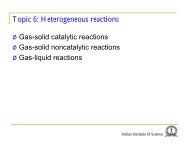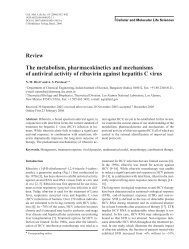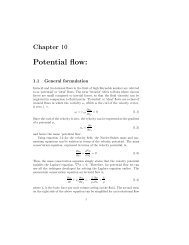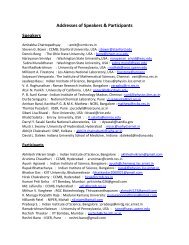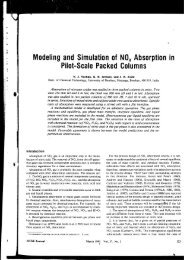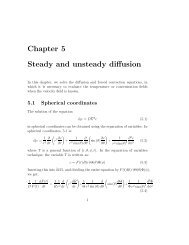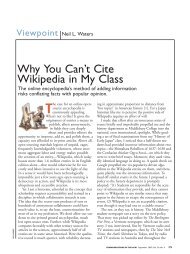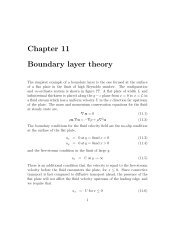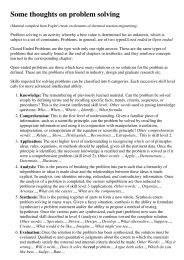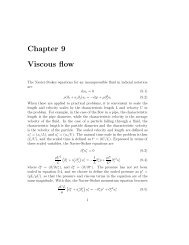Chapter 3 Unidirectional transport - Chemical Engineering ...
Chapter 3 Unidirectional transport - Chemical Engineering ...
Chapter 3 Unidirectional transport - Chemical Engineering ...
- No tags were found...
You also want an ePaper? Increase the reach of your titles
YUMPU automatically turns print PDFs into web optimized ePapers that Google loves.
2 CHAPTER 3. UNIDIRECTIONAL TRANSPORTto the solvent, resulting in an increase in the concentration near the surface.However, the concentration far from the surface z → ∞ remains unchangedat c = c ∞ . The conditions for the concentration field at the spatial boundariesand at the initial time arec = c ∞ as z → ∞ at all tc = c 0 at z = 0 at all t > 0c = c ∞ at t = 0 for all z > 0 (3.1)The problem is simplified by defining a non-dimensional concentrationThe conditions for c ∗ arec ∗ = c − c ∞c 0 − c ∞(3.2)c ∗ = 0 as z → ∞ at all tc ∗ = 1 at z = 0 at all t > 0c ∗ = 0 at t = 0 for all z > 0 (3.3)Heat transferThe configuration consists of a flat surface in the x−y plane of infinite extent,and a fluid of conductivity K and specific heat C p in the half space z > 0.Initially, the temperature of the fluid and the surface is T ∞ . At time t = 0,the temperature of the surface is instanteneously increased to T 0 . Determinethe temperature as a function of time.As conduction proceeds, there is a <strong>transport</strong> of energy from the surface tothe fluid, resulting in an increase in the temperature of the fluid. However,the temperature at a large distance from the surface, z → ∞, remains at T =T ∞ . Therefore, the conditions for the temperature at the spatial boundariesof the fluid and at initial time areT = T ∞ as z → ∞ at all tT = T 0 at z = 0 at all t > 0T = T ∞ at t = 0 for all z > 0 (3.4)The problem is simplified by defining a non-dimensional temperatureT ∗ = T − T ∞T 0 − T ∞(3.5)



